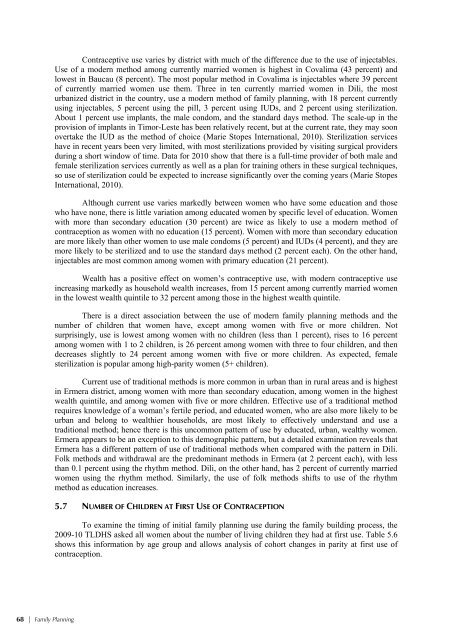Demographic and Health Survey 2009-10 - Timor-Leste Ministry of ...
Demographic and Health Survey 2009-10 - Timor-Leste Ministry of ...
Demographic and Health Survey 2009-10 - Timor-Leste Ministry of ...
You also want an ePaper? Increase the reach of your titles
YUMPU automatically turns print PDFs into web optimized ePapers that Google loves.
68 | Family Planning<br />
Contraceptive use varies by district with much <strong>of</strong> the difference due to the use <strong>of</strong> injectables.<br />
Use <strong>of</strong> a modern method among currently married women is highest in Covalima (43 percent) <strong>and</strong><br />
lowest in Baucau (8 percent). The most popular method in Covalima is injectables where 39 percent<br />
<strong>of</strong> currently married women use them. Three in ten currently married women in Dili, the most<br />
urbanized district in the country, use a modern method <strong>of</strong> family planning, with 18 percent currently<br />
using injectables, 5 percent using the pill, 3 percent using IUDs, <strong>and</strong> 2 percent using sterilization.<br />
About 1 percent use implants, the male condom, <strong>and</strong> the st<strong>and</strong>ard days method. The scale-up in the<br />
provision <strong>of</strong> implants in <strong>Timor</strong>-<strong>Leste</strong> has been relatively recent, but at the current rate, they may soon<br />
overtake the IUD as the method <strong>of</strong> choice (Marie Stopes International, 20<strong>10</strong>). Sterilization services<br />
have in recent years been very limited, with most sterilizations provided by visiting surgical providers<br />
during a short window <strong>of</strong> time. Data for 20<strong>10</strong> show that there is a full-time provider <strong>of</strong> both male <strong>and</strong><br />
female sterilization services currently as well as a plan for training others in these surgical techniques,<br />
so use <strong>of</strong> sterilization could be expected to increase significantly over the coming years (Marie Stopes<br />
International, 20<strong>10</strong>).<br />
Although current use varies markedly between women who have some education <strong>and</strong> those<br />
who have none, there is little variation among educated women by specific level <strong>of</strong> education. Women<br />
with more than secondary education (30 percent) are twice as likely to use a modern method <strong>of</strong><br />
contraception as women with no education (15 percent). Women with more than secondary education<br />
are more likely than other women to use male condoms (5 percent) <strong>and</strong> IUDs (4 percent), <strong>and</strong> they are<br />
more likely to be sterilized <strong>and</strong> to use the st<strong>and</strong>ard days method (2 percent each). On the other h<strong>and</strong>,<br />
injectables are most common among women with primary education (21 percent).<br />
Wealth has a positive effect on women’s contraceptive use, with modern contraceptive use<br />
increasing markedly as household wealth increases, from 15 percent among currently married women<br />
in the lowest wealth quintile to 32 percent among those in the highest wealth quintile.<br />
There is a direct association between the use <strong>of</strong> modern family planning methods <strong>and</strong> the<br />
number <strong>of</strong> children that women have, except among women with five or more children. Not<br />
surprisingly, use is lowest among women with no children (less than 1 percent), rises to 16 percent<br />
among women with 1 to 2 children, is 26 percent among women with three to four children, <strong>and</strong> then<br />
decreases slightly to 24 percent among women with five or more children. As expected, female<br />
sterilization is popular among high-parity women (5+ children).<br />
Current use <strong>of</strong> traditional methods is more common in urban than in rural areas <strong>and</strong> is highest<br />
in Ermera district, among women with more than secondary education, among women in the highest<br />
wealth quintile, <strong>and</strong> among women with five or more children. Effective use <strong>of</strong> a traditional method<br />
requires knowledge <strong>of</strong> a woman’s fertile period, <strong>and</strong> educated women, who are also more likely to be<br />
urban <strong>and</strong> belong to wealthier households, are most likely to effectively underst<strong>and</strong> <strong>and</strong> use a<br />
traditional method; hence there is this uncommon pattern <strong>of</strong> use by educated, urban, wealthy women.<br />
Ermera appears to be an exception to this demographic pattern, but a detailed examination reveals that<br />
Ermera has a different pattern <strong>of</strong> use <strong>of</strong> traditional methods when compared with the pattern in Dili.<br />
Folk methods <strong>and</strong> withdrawal are the predominant methods in Ermera (at 2 percent each), with less<br />
than 0.1 percent using the rhythm method. Dili, on the other h<strong>and</strong>, has 2 percent <strong>of</strong> currently married<br />
women using the rhythm method. Similarly, the use <strong>of</strong> folk methods shifts to use <strong>of</strong> the rhythm<br />
method as education increases.<br />
5.7 NUMBER OF CHILDREN AT FIRST USE OF CONTRACEPTION<br />
To examine the timing <strong>of</strong> initial family planning use during the family building process, the<br />
<strong>2009</strong>-<strong>10</strong> TLDHS asked all women about the number <strong>of</strong> living children they had at first use. Table 5.6<br />
shows this information by age group <strong>and</strong> allows analysis <strong>of</strong> cohort changes in parity at first use <strong>of</strong><br />
contraception.
















